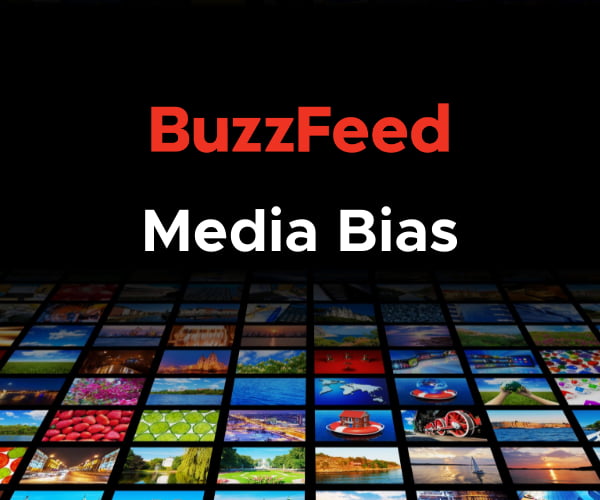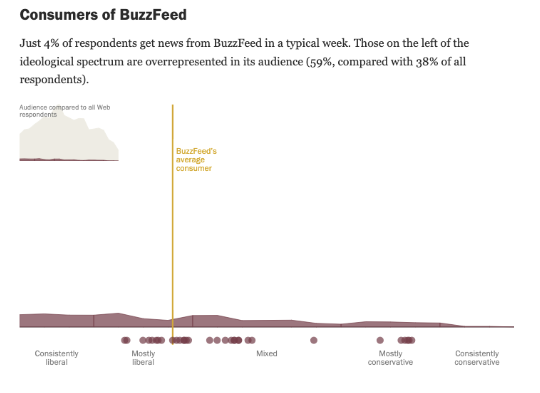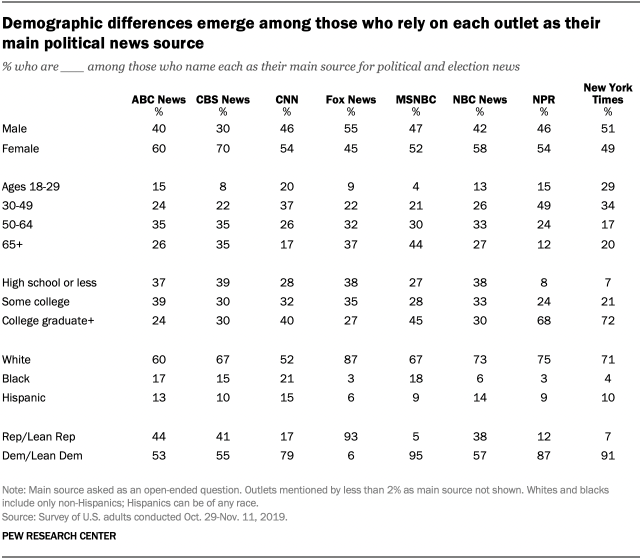
Buzzfeed’s birth started in 2006 when they chose to dedicate themselves to providing “trusted, quality, brand-safe news, and entertainment to hundreds of millions of people.” (Buzzfeed, 2023) Their goals were, “making content on the Internet more inclusive, empathetic, and creative; and inspiring our audience to live better lives.”(Buzzfeed, 2023) Buzzfeed has risen to the 22nd position in their category, and the 195th best-ranked news source in the U.S. They also total 97.3 million visits to their website each month, but what kind of quality are they providing to their audience base?
Since 2006, Buzzfeed has garnered a reputation for its investigative journalism. However, how likely is a news organization like Buzzfeed going to have a bias in its articles? For such an accoladed news organization, we must investigate to find the hidden truth in the articles published by Buzzfeed.

Source: Pew Research
In this article, we are going to investigate the bias of Buzzfeed articles and their editorial choices to find out if they have a perceptible political bias in their work. Our investigation should provide a definitive answer as to whether Buzzfeed is aligning to one side of the political spectrum and reveal the answers to the contributions of media bias in the public.
How Does Biasly Rate News Sources?
Biasly’s algorithms produce bias ratings to help provide multiple perspectives on given articles. Biasly has analyzed 200,000+ news articles from more than 3,200 news sources through our A.I. technology and team of political analysts to find the most factual, unbiased news stories.
Biasly determines the degree of political bias in news sources by using Biasly’s Bias Meter Rating, in which Biasly’s team analyzes media sources’ reliability and bias and produces three scores, a Reliability Score that measures the accuracy of media sources; an A.I. Bias Score, evaluated by A.I.; and an Analyst Bias Score evaluated by political analysts. These scores are rated based on seven rating metrics including Tone, Tendency, Diction, Author Check, Selection/Omission, Expediency Bias, and Accuracy. These metrics help our analysts to determine the political attitude of the article.
Our A.I. machine-learning system employs natural language processing and entity-specific sentiment analysis to examine individual articles and determine their bias levels. By analyzing the key terms in an article such as policies, biased phrases, political terminologies, politicians, and their nicknames, the algorithms can rate the attitude of the text. Bias scores range from -100% and 100%, with higher negative scores being more liberal and higher positive scores being more conservative, and 0% being neutral.
Is Buzzfeed Politically Biased?
Buzzfeed has faced much criticism in the last few months as their chief executive, Jonah Peretti, claims that Buzzfeed will be shuttered. They have reduced their workforce by 15%, and have decided to join Huffpost. According to John Peretti, in his CNN interview, “Moving forward, we will have a single news brand in HuffPost, which is profitable, with a loyal direct front page audience.” This leads us to wonder if this ‘loyal audience’ is going to drive the political direction of Buzzfeed and its writers as they prepare to become absorbed.
Biasly’s A.I. media rating for Buzzfeed is considered Very Liberal on the political scale. This means that Buzzfeed provides political coverage from an American liberal’s perspective of the news. They [Buzzfeed] typically praise left-wing politicians, policies, and agendas, while disparaging Republican and right-leaning ideologies. They pose a strong dislike to anything right of the center line in politics. Biasly’s score aligns closely with many third-party, non-biased research agencies, including MBFC who have determined Buzzfeed’s political bias to also be Left-leaning.
According to a Pew Research Study, 59% of Buzzfeed’s audience is liberal, so Buzzfeed has an incentive to favor their opinions. That is why Buzzfeed and their CEO John Peretti have continually shut down articles about former President Trump due to Trump’s “offensive” dialogue. For the rest of this article, we will look into the ability to discern bias in articles and how you can filter out opinion from fact. We will help you become a better and more informed reader of political news.
Before we begin, we need to discuss bias. Bias is a natural function of humans, and we can express it both consciously and unconsciously. Bias is one of the most fundamental forms of pattern recognition in humans. This isn’t to lower the bar and say that “all things are biased,” but to explain the process in which we may come to trust certain news organizations that display patterns of coverage.
On the media’s part, there is an incentive to retain audiences, encourage them to purchase subscriptions, and rate products positively. Bias is a two-way street, people want to see news stories about things they care about, and the media needs viewers to continue their operations. This creates a positive feedback loop that influences what stories are covered and from what perspective. This also explains the actions of more liberal news organizations.
Analysis of Bias in Buzzfeed Online Articles
According to DMR, Buzzfeed primarily consists of a millennial-based audience at 60%, and 50% of their age range is also made up of users between the ages of 18 to 34. Additionally, Similarweb says, “Buzzfeed.com’s audience is 43.10% male and 56.90% female. The largest age group of visitors are 25 – 34-year-olds (Desktop).” What we can take away from this is that most of the demographic that visits Buzzfeed comes from people who have more trust in the news and are younger. According to Pew Research Center, those with liberal views (like the audience at Buzzfeed) typically, “Express more trust than distrust of 28 of the 36 news outlets in the survey. NPR, PBS, and the BBC are the most trusted news sources for consistent liberals.”
Given the curiosity and relatedness that the younger generations have to today’s events, can they show bias? Do the readers contribute to the writer’s going down a slippery slope of bias as they get fewer or greater views? We shall examine more closely the articles of Buzzfeed to discover the clear signs of bias in writing today.

Source: Pew Research Center
When we analyze articles on bias it is important to look at these five factors: Tone, Tendency, Author, Diction, and Expediency Bias. The tone is the attitude with which the article has been written, and the tendency is about finding out how often that tone is used throughout the article. We can look at the author and determine their opinion and stance on issues based on past articles. We can look at the author’s choice of words to help us determine their bias as well, this is known as their diction. Lastly, we can more closely examine how quickly the article is released after an incident occurs to see what kind of bias is going to be present in the article through the author wanting to rush through the writing process to release their work before competitors.
The first article we are going to dive into is, “The First Capitol Rioter Was Sentenced And Won’t Get Any Jail Time.” Biasly has rated this article at -36% on the Bias meter making it very liberal. The reason for this rating is that the tone the author gives portrays a liberal perspective consistently throughout the article. One of the few things that help keep this article from being extremely liberal is its diction where the author chooses to use mild political leaning words and phrases throughout their article.
An example of this article’s tone and diction shows their stance on the political spectrum. This article’s author, Zoe Tillman says:
“Anna Morgan-Lloyd’s sentence sets a benchmark for the hundreds of people charged with low-level misdemeanors for participating in the Jan. 6 insurrection.”
Her use of the word insurrection shows some liberal bias, and the statement about the benchmark for prosecutions suggests that all of these protesters are going to get off with light sentences. The author espoused a liberal tone that stays consistent throughout her article, with unique words that suggest a left political affiliation. However, her diction throughout the article stays mostly mild but clear to her viewpoint.
The author, Zoe Tillman, is often making left-leaning, liberal articles. Some of her articles include, “The Far-Right Troll Known As “Baked Alaska” Just Blew Up His Own Jan. 6 Plea Hearing” and “Prosecutors Escalated The Stakes For Proud Boys Leaders In The Latest Jan. 6 Seditious Conspiracy Indictment.” Tillman clearly and consistently posts articles with headlines that force the reader to make left-leaning assumptions about the topics she writes on.

Source: Buzzfeed.News

Source: Buzzfeed.News
In the “Baked Alaska” story she uses an image of Gionet on a phone inside the Congressional House, portraying him as guilty, and leading the reader to assume the same. In the “Proud Boys” article Tillman uses heavy-handed language like, “Seditious” and “Escalated the Stakes” in her title to force the reader to assume the Proud Boys. Furthermore, she uses a photo of the Proud Boys leader walking down the street in his body armor during a protest to make us assume that the Proud Boys leader is guilty. In both articles, Tillman decides to release her story as the events happen on those days. You will see when looking at the story that she initially posts her story about the Proud Boys at 3:35 p.m. and then later updates it at 5:29 p.m. In her other article about “Baked Alaska”, she posts the story at 12:22 p.m. and this shows that she is choosing to release her stories earlier, knowing that they will be less accurate and more biased. This is a form of expediency bias where the author chooses to act quickly rather than to take the time to receive clarity and understanding about what she is writing.
To conclude our investigation into the media bias that Tillman portrays, we discover that she has a liberal bias. Regardless of the story she writes, Tillman makes it clear that only the left is correct and that no other opinions could be true. This is why it is important to pick apart articles from any news organization and to examine the bias they contain by looking for the tone, tendency, author, diction, omission, and expediency bias.
Next, we will take a look at an article from Buzzfeed that shows no bias and is rated as zero on the Biasly Meter. This article is titled “Rudy Giuliani Has Been Suspended From Practicing Law In New York,” and the rating for this article is centric because the tone and tendency do not change as it is very matter-of-fact. Further, the article stays to the truth without many opinions added in as fluff from the author. This article is objective and does not have any extreme language from either side of the political spectrum. The article discusses the suspension of Rudy Giuliani and states that:
“His suspension from the New York State Bar is effective immediately, and it is indefinite “pending further proceedings before the Attorney Grievance Committee,” and “Giuliani will have 20 days to submit a request for a post-suspension hearing.”
As a trustworthy and objective source of information, the Buzzfeed article, “Rudy Giuliani Has Been Suspended From Practicing Law In New York,” stands out. The article keeps a centered tone throughout and presents the data in an unbiased and factual way, earning a score of zero on the Biasly Meter policy leanings. It avoids adding pointless views or excessive words from any political perspective. Although the author briefly expresses some mildly left-leaning opinions, the story is objective and thorough, covering all relevant facts. This article offers a fair assessment of the circumstances by outlining Giuliani’s immediate suspension from the New York State Bar and the ongoing procedures before the Attorney Grievance Committee.
Analysis of Buzzfeed Opinion Articles
Before we get into and pick apart Buzzfeed’s opinion pieces we need to first learn about the difference between reporting and giving an opinion. Opinions provide a platform for columnists to express their individual views on the hot-button views and issues of the day. Whereas reporting is meant to be objective, providing the reader with information and quotes from primary sources to enable them to create their own opinion. Although the investigation we did above had some factual reporting, the Buzzfeed opinion columns and articles stress expressing their own opinions over seeking neutrality.
Think about the editorial, “Dangers Lurk Aboard Cruise Ships. The Cruise Passenger Protection Act Can Help.” This title and article include bias because it contains strong wording that implies a bad opinion or judgment about the security of cruise ships, Specifically the words “Dangers” and “Lurk” indicate that all cruise ships are unsafe and are always just around the corner. The title also implies that the only way to help stop this is through the “Cruise Passenger Protection Act” which the author of the article, Sen. Richard Blumenthal proposed to Congress. This is liberal-leaning because it asks for taxpayer money to be provided to support and increase the security on cruise ships. The author does not seem to be trying to offer a balanced and impartial account of the facts rather that only his proposed bill can help and that we need to support the bill.
However, the article, “Here’s What You Need To Know About The Dominion V. Fox News Trial That Starts This Week” has a more neutral title that emphasizes educating the reader rather than advancing an agenda. Neutral language and data from reliable sources are indicators of an unbiased article. It is fair to predict that this article will be more impartial than the one before it based solely on its title.
These articles, along with those mentioned above, are only a fraction of Buzzfeed’s overall content, but they show that the publication frequently features a lot of opinions, emphasizing the significance of understanding how to differentiate opinion writing from accurate reporting. It is also important to understand the difference between reporting and opinion pieces. Accurate reporting provides sources from both sides of an issue with neutral language and unbiased commentary from the reporter. However, opinion pieces are stories written to express the writer’s opinion on the subject matter which is acceptable as long as the authors do not mislead their readers.
Who Owns Buzzfeed?
Buzzfeed News is owned by Buzzfeed Incorporated. NBCUniversal invested $200 million in Buzzfeed in 2015, after initially utilizing venture capital to get itself started in its early years. In 2016 NBCUniversal made an additional $200 million investment into the news company. About a third of Buzzfeed is owned by NBCUniversal and its Comcast affiliate together. According to Buzzfeed, it wishes to maintain its independence. Buzzfeed Incorporated decided to buy Huffington Post in a stock agreement in November 2020. Therefore, one-third owners of Buzzfeed and Huffington Post are NBCUniversal and Comcast. The chairman, president, and CEO of Comcast is Brian L. Roberts. Comcast is a publicly listed company. It was also announced in 2020 by Perreti that Buzzfeed News will be taken over by the Huffington Post. In a quote from Buzzfeed, CEO Peretti, says,
“I have vivid memories of growing HuffPost into a major news outlet in its early years, but BuzzFeed is making this acquisition because we believe in the future of HuffPost and the potential it has to continue to define the media landscape for years to come,” Peretti continued. “With the addition of HuffPost, our media network will have more users, spending significantly more time with our content than any of our peers.”
Given that NBCUniversal owns about a third of the company it is reasonable to assume that’s the reason for the Left-leaning slant in their articles and that all the owners favor a Democrat-centric ideology.
How to Evaluate and Uncover Bias
It can often be difficult to tell if the news you watch is biased. If you have settled on a news channel, it’s usually because you trust the information you are gaining. Unfortunately, many trust the information they are hearing because it confirms what they already believe. This is referred to as “confirmation bias.” It is important to challenge your beliefs and get third-party verification that what you are hearing is the full story. This is why we recommend using Biasly to compare different news stories side-by-side using our bias ratings to figure out what both sides think of a political issue.
Even though Buzzfeed received a “Very Liberal” bias score from Biasly, keep in mind that bias varies per article and that Buzzfeed is not always publishing liberal news. In reality, it is well known to have published articles from a centric and conservative standpoint from time to time. General news articles are renowned for being less biased than opinion pieces. Although every story you read will contain tone to some extent, some articles stick to the facts more closely than others. For this reason, it is critical to utilize Biasly’s News Check to identify the bias of the articles that you read.






















